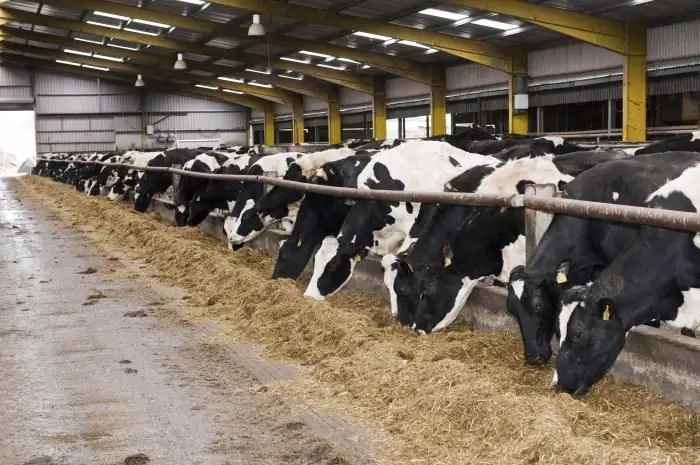2026 Author: Howard Calhoun | [email protected]. Last modified: 2025-01-24 13:10:26
Climatic testing is one of the methods for testing the resistance of products to external factors. Unfavorable environmental conditions can lead to equipment failure, critical state of structures and the risk of their collapse, damage to the integrity of protective coatings, loss of appearance and intensification of corrosion processes. Such tests can be carried out in special closed chambers or at test sites using several methods.
General concept
Technical products operating in the open atmosphere are affected by various climatic factors that worsen their performance: high humidity, solar radiation, low and high temperatures. They are taken into account when designing products. So, depending on the location of the area where the equipment will be operated, the climatic design is determined and the appropriate materials are selected that meettechnical requirements.
Climatic tests are used to evaluate the functional qualities (reliability, resistance to destruction and stress, tightness) and appearance under specified operating conditions. As studies show, the most dangerous factors under the influence of which negative physical and chemical processes occur in materials are low temperatures (brittleness increases), high humidity (acceleration of corrosion processes) and sudden temperature changes.
Climate test results can be assessed both qualitatively and quantitatively. They are usually carried out at the stage of development work, as well as in mass production as a rejection of critical structures (technological tests on a regular basis) and to check the stability of quality (periodic control).
Methodology
The method of climatic testing according to GOST 24813-81 depends on the technical requirements that the consumer places on products, design features, the manufacturing and installation process, as well as on operating conditions. They are set by relevant industry standards and design documentation.
Tests are carried out in 3 stages:
- Preliminary aging in specified climatic conditions. This is required to eliminate the influence of previous conditions (humidity, temperature, pressure). The duration of this stage is determined by the time required for the thermalequilibrium. At the same time, initial measurements and a visual inspection of the object are carried out.
- Exit parameters to the operating mode, shutter speed, extraction from the camera (from the test site), stabilization of external conditions for the subsequent evaluation of the object. The test mode can be short, long or cyclic.
- Seeing and measuring changes, drawing conclusions. Development of a predictive nature of changes in operational characteristics.
If the object consists of several elements, then, in agreement with the customer, these works can be carried out as part of the entire product.
Preparatory stage. Test technology design
Preparation for a climate test includes the following procedures:
- Designing a mathematical model of an object.
- Collecting information about a possible change in the functional or external properties of the product under the influence of climatic factors.
- Choosing test and measurement tools, establishing the scope and sequence of work, drawing up a schedule, developing a methodology.
- Planning material, technical and metrological support.
- Define reporting forms.
- Instructing service personnel.
- Debug test tools.
- Choice of means for processing received data.
Classification

Climatic tests are classified according to 3 criteria: by the method of execution, by the method of exposure and by the type of climaticfactor.
In the first case, there are 3 types of such work:
- Single trials. The product is affected by only one of the climatic factors. For one test, they can change sequentially, but their effect on the object is independent. The advantage of this method of climatic testing is the simplicity of the equipment. The disadvantages include incomplete compliance with real operating conditions.
- Compound tests. The object is also affected by only one single factor, but it is enhanced by the influence of the previous factor. An example would be placing a product in a high humidity environment and then lowering the temperature.
- Complex tests. The object is simultaneously affected by a complex of climatic factors. This type is the most reliable, as it is as close as possible to the operating conditions. Its disadvantage is the need for complex test setups.
Field and accelerated tests

According to the method of impact on the object, full-scale and accelerated climatic tests are distinguished. The latter type is often used for protective coatings and plastics. Since their destruction occurs over a long period of time, in order to reduce the time for obtaining results, products are affected by cycles that simulate changes in conditions over several months or years (temperature and humidity changes, solar radiation). Impact is determined by one or more indicators.
The methodology for accelerated testing of paint coatings and polymers is given in the standards of the Unified Corrosion and Aging Protection System (ESZKS).
Climatic factors
Classification of climatic tests is also carried out according to the type of influencing factor:
- High or low atmospheric pressure.
- Precipitation (rain, snow, frost, ice).
- High or low humidity.
- Sea fog saturated with s alts.
- High or low temperature.
- Wind load.
- Atmosphere, moisture or soil saturated with corrosive substances.
- Sudden temperature changes.
- Increased solar insolation.
- Exposure to dust and sand.
Testing Tools

Most often, products are tested in special chambers (artificial weather chambers), where appropriate climatic conditions are artificially created. The object is installed so that the greatest stability is ensured and there is free air circulation between it and the walls of the installation. The equipment of climatic chambers for testing can be different and depends on the requirements for the work. There are the following types of such installations:
- heat-cold-moisture;
- heat and deep freeze;
- s alt spray;
- with wind tunnels (for wind testing);
- light aging;
- thermal shock (a drop is created in themtemperatures);
- rain;
- solar radiation with sources of infrared and ultraviolet radiation;
- thermal vacuum chambers and others.
Low temperatures are achieved using refrigerants (liquid nitrogen, carbon dioxide, ammonia) or compression evaporative units.
All environmental testing equipment must be periodically tested for performance and have devices that prevent failure due to human error and external factors.
Testing large items
Research of the possibilities of technical devices or large structural elements is carried out at polygons (climatic stations). In Russia, the only scientific center for climate testing is located in Gelendzhik (GTsKI VIAM). Since 1925, it has been researching materials for the aviation industry and working out systems for protecting against corrosion, aging and biodamage.

There are also large climatic test chambers (climate rooms, Walk-In) with a separate entrance. They serve for complex effects of temperature and moisture.
Requirements for test items

Climatic tests are allowed for products that have undergone final assembly and meet the requirements of regulatory and technical documentation in terms of appearance and operational parameters at a pressure of 1 atm. and a temperature of 20 °C.
In the absence of overall test chambers, it is allowed to carry out the impact on parts of the object. If the structural elements in real operating conditions are in different conditions, then 3 options for testing are possible:
- for each part separately (if this does not violate the performance);
- as a whole for the entire product under the most unfavorable climatic factors;
- on the layout, fully constructive and technologically appropriate to the object.
Features of corrosion resistance tests using chemically aggressive substances

Tests with the use of corrosive substances are carried out in special chambers. According to the type of aggressive environment, 3 types of work are distinguished:
- in the atmosphere (taking into account the content of chlorides, sulfur dioxide, nitrogen oxides, hydrogen nitrite and other compounds);
- in water with a certain acidity, salinity, content of dissolved carbon dioxide, hydrogen sulfide, oxygen, calcium, magnesium and other chemical elements;
- in the soil, the main characteristics of which are moisture, salinity, state of aggregation, concentration of chlorides, nitrates, sulfates, carbonates and other corrosive substances.
Analysis of results
After testing, record the values of the measured parameters and qualitative data. The report indicates the following information:
- goal of work;
- venue and applied technicalfunds;
- permitted deviations from the normative documentation and the reasons for their adoption;
- detected defects;
- measurement results;
- Recommendations for finalizing the design or for additional testing.
Climatic testing of coatings

The service life of protective coatings is highly dependent on climatic conditions and can vary widely. The following factors have the greatest influence:
- Light and warmth. To a greater extent, this applies to the ultraviolet region of solar radiation, since short-wave rays destroy the binder components in the composition of paint and varnish coatings. The result is an increase in their fragility, loss of luster and brightness.
- Temperature fluctuations. Under natural conditions, they can reach 20 ° C in 1 hour. High temperatures accelerate photochemical reactions in the film former, low temperatures lead to brittleness of the coating, and their difference leads to cracking due to changes in internal stresses.
- Humidity to soften and swell protective films.
- Precipitation and fog.
- Presence of abrasive particles and wind.
Because coatings are naturally exposed to a range of factors at once, standard chamber test methods cannot reproduce these effects.
Climatic testing of coatings at landfills is carried out in accordance with GOST 6992-98. Samples are placed on stands (on an open area of land or on the roof of a building), at an angle of 45 ° tohorizon, facing south. This arrangement allows accelerated testing under the influence of weather conditions. Vertical placement better matches real conditions, but it requires a longer test.
Before installation at the landfills, a preliminary exposure to one of the climatic factors in the chambers is carried out. To do this, select the type of aggressive impact that has the greatest effect on the coating in these operating conditions. The assessment of the safety of properties is carried out according to GOST 9.407-2015.
Recommended:
Analysis of shares: methods of conducting, choosing methods of analysis, tips and tricks

What are stocks. How to analyze stocks, what sources of information are used for this. What are the risks associated with buying shares? Types of stock analysis, what formulas are used. What are the features of the analysis of shares of Russian companies, tips and tricks for collecting information and analyzing shares
High voltage test: types, methods and rules for conducting

Today, people actively use a variety of electrical equipment, power cables, electrical connections and more. Since in some equipment the voltage can reach enormous values that can cause irreparable harm to human he alth, periodic monitoring is required. High voltage test is one of the methods for detecting insulation defects
Cow life expectancy: factors and methods for determining age

Everyone knows the average life expectancy of a person, but he is not alone on earth. There are many animals without which mankind cannot exist, and it has been so since ancient times. But no one ever thinks about how long our friends and helpers, and sometimes breadwinners, should live. For example, how long does a cow live?
High-voltage tests: purpose, algorithm, test methods, standards, protocol and compliance with safety rules

The operation of electrical equipment involves a number of high-voltage tests. They are very important for the correct operation of the devices. Their purpose. the algorithm for conducting, norms and compliance with safety rules are described in detail in this article
Trade and production holding "Rusclimat": reviews. Manufacturer and distributor of climatic equipment TPH "Rusklimat"

Holding "Rusclimat" for more than 20 years offers customers a variety of climate solutions for home, manufacturing plant or office space. The organization has thousands of completed projects for individuals and legal entities

